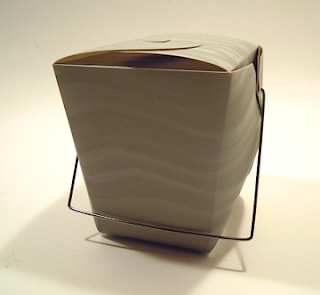While cruising the aisles of a dollar store last week, I came across a lone grey oyster pail and decided it looked a little like an elephant—or at least enough like an elephant that it could be used as a starting point.
Although these types of boxes are often associated with Chinese food in North America and Europe, their origins as food containers have nothing to do with the Far East.
In the early twentieth century, fresh oysters were much more plentiful and far cheaper than they are today. And, because it can be difficult and even dangerous to pry open an oyster shell to get at the oyster inside, shoppers often had the oyster seller shuck the oysters for them. The cardboard oyster pail was accordingly developed to hold the shucked oysters. Because it was more or less leakproof, oyster pails were also used to hold honey around this time.
By the middle of the twentieth century, overfishing and the resulting rise in price made oysters far less profitable. This left the manufacturers of oyster pails with large quantities of unsold boxes. Enter the world of convenience foods and takeout.
Following the Second World War, as the American economy boomed, there was a massive rise in foods that could be prepared quickly and easily—especially foods that could be simply brought home and warmed up. Chinese food became particularly popular, because it was inexpensive, slightly exotic, and tasty. Oyster pails were suddenly given a new lease on life. Not only did they provide a small degree of insulation, but they could also be used to pack everything from rice to dishes with sauce.
 |
| American Chinese food containers. Photo: Donald Bowers Source: http://djbphoto.blogspot.ca/2011/02/its-actually-called-oyster-pail.html |
Interestingly, oyster pails used as "Chinese food containers" are rarely seen outside the United States, although a few European countries have begun to adopt them. They are not used for this purpose in China—although China now manufactures them in massive quantities for export.
Today, in addition to their use as takeout food containers, oyster pails are often used to hold party favours and small gifts, and come in a wide range of colours and materials.
For today's elephant, I bought a grey oyster pail made of thin plastic. I thought the folded flaps at the top would look like ears when opened, and the triangles formed by the folds on the sides looked like legs to me. This particular box also had an interesting textured pattern on the outside, which I thought looked a little like elephant skin.
This is what it looked like opened up.
Faced with this basic shape, I decided to paint ears on the wide side flaps, a face on the front, a tail on the back, and toenails on the feet for a friend who likes her elephants to have pretty toenails. I used acrylic paint for everything, which is unfortunately likely to crack and fall off sooner rather than later. If this were painted on a pasteboard version, obviously the paint would be more durable.
It only took about half an hour to paint this, once I figured out where everything should go. Before I started painting, I did open the whole thing up to see if an elephant made more sense folded another way. Although I could see some interesting potential elephant shapes when the box was disassembled, I decided to stick with the basic shape.
The best thing about this is that, when it's all folded up, you don't see any elephant at all, except for its toenails. This makes me think that it would be a fun thing to make for a children's party as a loot bag or something similar.
I know it won't last, and it's not really sturdy enough to hold anything substantial, but it's kind of cute for what it is, so I'll keep it around at least as long as its paint job lasts.
Elephant Lore of the Day
In 2007, while being taken for a walk through the Oregon Zoo, little Chendra's eye was caught by an unusual creature swimming through one of the Zoo's aquarium areas.
As Chendra paused with her handlers, Gus the sea lion swam over to the glass. Chendra reached out her trunk, and Gus lifted his head, as though to allow Chendra tickle his neck.
It was unfortunately the first and last encounter for the two, as the Zoo soon stopped taking elephants for morning walks—partly, no doubt, because the elephants grew too large to fit inside the tunnel-like area.
Sadly, both species are endangered. Asian elephants are critically endangered in some countries, and highly likely to become extinct in others. Steller sea lions such as Gus are also threatened, with a worldwide population that has declined by more than 80 per cent over the past thirty years, due to pollution, habitat degradation, and entanglement in fishing nets and lines.
This is not the first time I've heard of elephants appearing to interact with marine species. In a previous post, I mentioned an incident witnessed by the late biologist Lyall Watson, who watched as an elephant on a clifftop appeared to be serenading a whale in the bay below.
To Support Elephant Welfare
Boon Lott's Elephant Sanctuary (Thailand)
Wildlife SOS (India)
The Elephant Sanctuary (Tennessee, U.S.A.)
Fauna & Flora International Wildlife SOS (India)
The Elephant Sanctuary (Tennessee, U.S.A.)








No comments:
Post a Comment